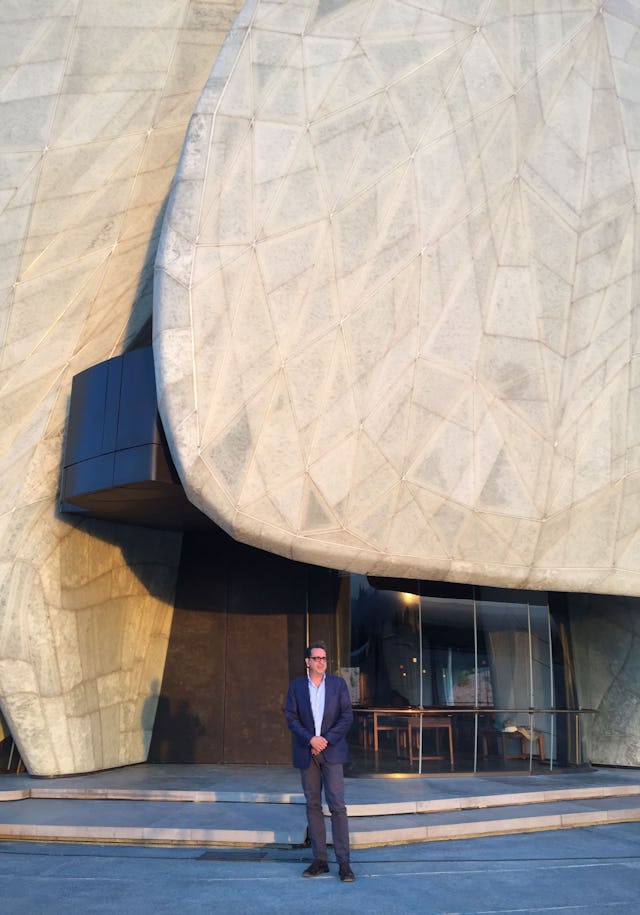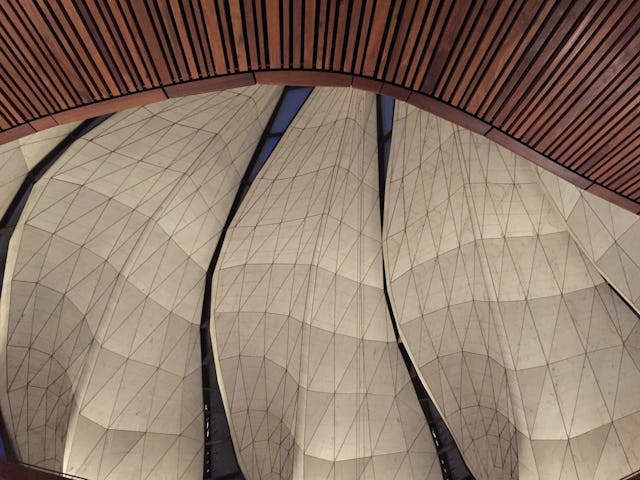Where spirit and form fuse: reflections on the architecture of the Chile Temple
SANTIAGO, Chile — Siamak Hariri is visibly moved as he surveys the Baha'i House of Worship here that has taken his Toronto-based architectural team, and hundreds of other contributors from all around the world, some 14 years to bring to completion.
"You have a sense of what it will be because you've been so intimately involved in every detail," he says, "but it's so much more than our imaginations could have predicted."
The architect has returned to Santiago to see the building for the first time in its finished state and is clearly delighted by the results which he says could not have been foreseen, despite the years of highly detailed design and preparation.
"We looked at it on the computer a million times," he says, "but the effect of it - the way that the light is captured in the glass, how it comes through and just touches the marble - that was one of our biggest worries. Would that in fact happen? It was a theory, we tested it, and we hoped that it would. But now that we see it, it's way beyond what we could have imagined."
The House of Worship, according to the architecture website ArchDaily, "defies rational thought and veers into the realm of the emotional."
It is a masterpiece of state-of-the-art engineering which at once has the presence of an ancient monument and the appearance of a natural form that has sprung organically from its environs.
"The temple appears otherworldly," wrote renowned Canadian author Noah Richler in the design magazine Azure, "yet of the mountainside and belonging to it."
Now, as final preparations are made for the House of Worship's dedication ceremonies, the light-suffused building already possesses an ineffable spirit which will intensify in time as prayers, the reading of sacred scriptures and songs of worship resound through its auditorium.
Mr. Hariri says that his team consciously knew the power a building can have to affect the soul, but the challenge to evoke such a sense was a profound one.
"How do you make a single room that is a material structure but has a spiritual effect? It's a tough assignment."
At the outset, it was decided that inspiration for the structure would not come from other buildings.
"We were not going to look at architecture," he says. "New civilization and new expression means that we could not take too much from what is around us right now."
Rather, the team went in search of a "feeling", hoping that visitors to the Temple would have the sense that they were gazing up at the heavens or turning towards the light, just as a plant moves to face the sun.
"I think that you try for it but you cannot predict the deep emotional impact," Mr Hariri says. "We were very deliberate in aiming for that ethereal glow, the softness, the upward spiraling. But it has gone way beyond that."
"For example, we were hoping for that kind of rawness of the surface concrete against the shimmering quality of the glass. But this is really magic, because of all the effects of light and material, and movement against those materials."
Innovation and creativity
It was in 2002 that the National Spiritual Assembly of the Baha'is of Chile invited design proposals from architects for the last of the continental Baha'i Houses of Worship. Specifically it was to be "a nine-sided domed structure with nine entrances to symbolically welcome people from all directions of the earth for prayer and meditation."
But Mr. Hariri - whose firm Hariri Pontarini Architects entered the competition - says the brief was also open enough to leave room for innovation and creativity.
Inspiration for elements of the design were found in, among other things, the veins of a leaf, the interwoven threads of Japanese baskets, and the depiction of the softness of robes in oil paintings.
A multidisciplinary team, from engineers to musicians, worked with the architects to conceive the structure. Three-dimensional modelling software called CATIA, used in aerospace engineering and rarely in architecture, was adopted to map out the design.
"Thirteen years ago this was breathtakingly hard," says Mr Hariri. "We were the only ones in Canada who were working in CATIA."
Writing at the time, Lisa Rochon — architecture critic for Canadian newspaper The Globe and Mail — described the "structural ambitions of the project" as "formidable."
Yet a building that at many points in its development seemed impossible to achieve, particularly in a location prone to earthquakes, has been magnificently realized. In its finished form, nine identical wing-like panels of translucent cast glass curve around to form the temple's dome. Natural light passes through the glass and floods the white marble interior while at night, light emanates softly from within the structure.
To retain the luminescent quality of glass, while having the strength of stone, a team of artists, engineers, and architects had to create a material that was fit for purpose, structurally and visually. With the help of celebrated glass artist Jeff Goodman, known for his ornate blown glass chandeliers, a new approach to casting glass was tested in more than 200 different forms before being finalized.
"Its innovative cast-glass skin is a victory for the architects, engineers, fabricators, and contractors who sweated every detail to make sure it could withstand the rigors of its mountainside location," Deborah Soonian Glenn wrote for the American monthly, Architectural Record.
The innovations in technology and design are combined with traditional Chilean craftsmanship and materials. Every fixture, the seating and the lighting, has been treated with the same, loving attention to detail.
"We were trying to get a candlelit, monastic feeling," says Mr. Hariri. "And it's even better than we imagined."
Designing for future generations
Standing now at the House of Worship for the first time since its completion, the architect, reflective and deeply moved, is thinking of the generations of visitors who will enter beneath its dome in centuries to come, seeking out its atmosphere of peace and tranquility, and finding in its message of hope and unity the inspiration to devote themselves to service to the community.
"It's the culmination of a few years of work for us, but it's going to be there for a long time," he reflects.
"Deep down I am thinking of my children and my grandchildren, and all of the millions of souls that this building might touch. I can imagine them in the temple."
"I have never experienced this with a building before," he says, "not on the first day."

